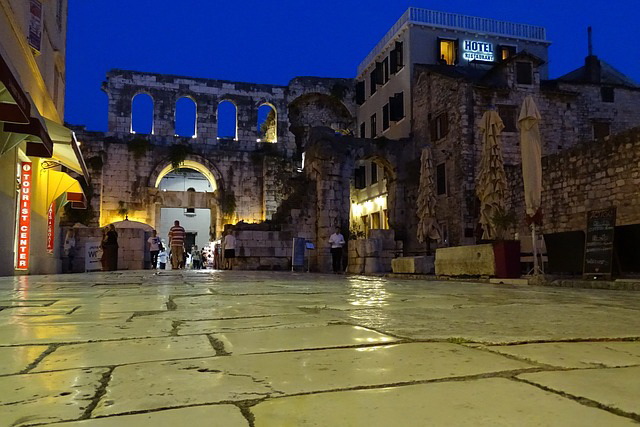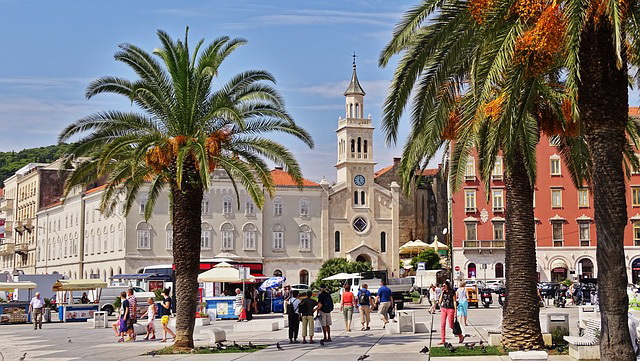|
||
The so-called palace was a massive structure and contains not only the palace itself but also buildings, intended for housing military garrison.
The ancient fortress has become the old town of Split, with numerous shops, cafes, restaurants and also apartments, located in the old buildings on narrow streets of the palace/fortress. Around 3000 people live on the territory of Diocletian’s palace today. Emperor Diocletian had a wish to enter his palace on a ship, without leaving the deck. Today, it is hard to imagine that the lower tier of Diocletian’s palace once was covered with water, and the ship of the Emperor was usually slowly passing between the columns and stopping among the vaulted rooms of the lower tier. The windows in the lower rooms of the palace are located near the ceiling - in case the water would rise - and even during the day the illumination here is weak, uneven. Over time, the sea receded, and a city emerged around the palace.
The rest of the old city is covered with white stone buildings of different periods and styles. The palace was built from local limestone and white marble. The palace has a form of an irregular rectangle with numerous towers on the western, northern, and eastern facades. The southern façade has no towers, because it was rising directly from the waters of the sea. The design of the palace is a mix of villa and castrum architecture. The Emperor’s apartments were located on the southern part of the complex - along the seaside. Only the foundation and lower floors of these apartments have survived to our days. Diocletian’s octagonal mausoleum (later was reconstructed into a Christian church - one of the oldest in the world) and 3 temples were also located in the southern part of the palace. One of the temples was later turned into a baptistery, the other two were destroyed. On the crossroad of the two main roads of the palace, the so called Peristyle is located. The Peristyle is a rectangular open court decorated with colonnade and intended to become the heart of the palace, where the most powerful Roman citizens were gathering. The palace had four gates. From the Golden gate on the northern side of the fortress the road to the town of Solin was starting.
When the night falls, the marble and granite columns, topped by Corinthian capitals, are usually illuminated by colorful garlands, and the interiors of the palace are becoming a beautiful scene, where actors in Roman togas are performing with their solemn voices, echoing under the arches of this ancient palace. |
MENU |
|
|
|
|
|
CONTACT Croatian National Tourism Board Address: Tel: +385 (0)1 4699 333 Email: info@htz.hr
|
|
|
||
|
© DiocletiansPalace.org - All Rights Reserved |
 The whole complex occupied around 30,000 square meters. Today these ruins lie in the heart of
the city of Split in Croatia.
The whole complex occupied around 30,000 square meters. Today these ruins lie in the heart of
the city of Split in Croatia. Not much is left in Split from the era of Diocletian - only the palace, the remains of walls and
gates.
Not much is left in Split from the era of Diocletian - only the palace, the remains of walls and
gates.